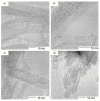Nanotube Functionalization: Investigation, Methods and Demonstrated Applications
- PMID: 35955321
- PMCID: PMC9369776
- DOI: 10.3390/ma15155386
Nanotube Functionalization: Investigation, Methods and Demonstrated Applications
Abstract
This review presents an update on nanotube functionalization, including an investigation of their methods and applications. The review starts with the discussion of microscopy and spectroscopy investigations of functionalized carbon nanotubes (CNTs). The results of transmission electron microscopy and scanning tunnelling microscopy, X-ray photoelectron spectroscopy, infrared spectroscopy, Raman spectroscopy and resistivity measurements are summarized. The update on the methods of the functionalization of CNTs, such as covalent and non-covalent modification or the substitution of carbon atoms, is presented. The demonstrated applications of functionalized CNTs in nanoelectronics, composites, electrochemical energy storage, electrode materials, sensors and biomedicine are discussed.
Keywords: carbon nanotubes; covalent modification; filling nanotubes; non-covalent modification; substitution of atoms.
Conflict of interest statement
The authors declare no conflict of interest.
Figures











Similar articles
-
Functionalization of nitrogen-doped carbon nanotubes with gallium to form Ga-CN(x)-multi-wall carbon nanotube hybrid materials.Nanotechnology. 2012 Aug 17;23(32):325601. doi: 10.1088/0957-4484/23/32/325601. Epub 2012 Jul 23. Nanotechnology. 2012. PMID: 22825368
-
Covalent Functionalization of Multi-Walled Carbon Nanotubes Surface via Chemical Treatment.J Nanosci Nanotechnol. 2017 Apr;17(4):2463-470. doi: 10.1166/jnn.2017.13311. J Nanosci Nanotechnol. 2017. PMID: 29648764
-
Electrochemistry of Carbon Materials: Progress in Raman Spectroscopy, Optical Absorption Spectroscopy, and Applications.Nanomaterials (Basel). 2023 Feb 6;13(4):640. doi: 10.3390/nano13040640. Nanomaterials (Basel). 2023. PMID: 36839009 Free PMC article. Review.
-
Ullmann Reactions of Carbon Nanotubes-Advantageous and Unexplored Functionalization toward Tunable Surface Chemistry.Nanomaterials (Basel). 2019 Nov 15;9(11):1619. doi: 10.3390/nano9111619. Nanomaterials (Basel). 2019. PMID: 31731640 Free PMC article.
-
Nanotubes in biosensing.Wiley Interdiscip Rev Nanomed Nanobiotechnol. 2010 Sep-Oct;2(5):496-509. doi: 10.1002/wnan.94. Wiley Interdiscip Rev Nanomed Nanobiotechnol. 2010. PMID: 20803683 Review.
Cited by
-
Metal and Metal Halogenide-Filled Single-Walled Carbon Nanotubes: Kinetics, Electronic Properties, Engineering the Fermi Level.Nanomaterials (Basel). 2022 Dec 30;13(1):180. doi: 10.3390/nano13010180. Nanomaterials (Basel). 2022. PMID: 36616090 Free PMC article. Review.
-
Synthesis, Sorting, and Applications of Single-Chirality Single-Walled Carbon Nanotubes.Materials (Basel). 2022 Aug 26;15(17):5898. doi: 10.3390/ma15175898. Materials (Basel). 2022. PMID: 36079282 Free PMC article. Review.
-
Therapeutic approach of carbon nanotube: Revolutionize nanomaterial in biomedical and pharmaceutical sector.J Food Drug Anal. 2024 Dec 15;32(4):412-427. doi: 10.38212/2224-6614.3531. J Food Drug Anal. 2024. PMID: 39752868 Free PMC article. Review.
-
Kinetics, Electronic Properties of Filled Carbon Nanotubes Investigated with Spectroscopy for Applications.Nanomaterials (Basel). 2022 Dec 30;13(1):176. doi: 10.3390/nano13010176. Nanomaterials (Basel). 2022. PMID: 36616086 Free PMC article. Review.
-
Functionalized Fullerenes and Their Applications in Electrochemistry, Solar Cells, and Nanoelectronics.Materials (Basel). 2023 Feb 2;16(3):1276. doi: 10.3390/ma16031276. Materials (Basel). 2023. PMID: 36770286 Free PMC article. Review.
References
-
- Kharlamova M.V. Electronic Properties of Pristine and Modified Single-Walled Carbon Nanotubes. Phys.-Uspekhi. 2013;56:1047–1073. doi: 10.3367/UFNe.0183.201311a.1145. - DOI
-
- Kharlamova M.V. Advances in Tailoring the Electronic Properties of Single-Walled Carbon Nanotubes. Prog. Mater. Sci. 2016;77:125–211. doi: 10.1016/j.pmatsci.2015.09.001. - DOI
-
- Burdanova M.G., Liu M., Staniforth M., Zheng Y., Xiang R., Chiashi S., Anisimov A., Kauppinen E.I., Maruyama S., Lloyd-Hughes J. Intertube Excitonic Coupling in Nanotube Van Der Waals Heterostructures. Adv. Funct. Mater. 2022;32:2104969. doi: 10.1002/ADFM.202104969. - DOI
-
- Kashtiban R.J., Burdanova M.G., Vasylenko A., Wynn J., Medeiros P.V.C., Ramasse Q., Morris A.J., Quigley D., Lloyd-Hughes J., Sloan J. Linear and Helical Cesium Iodide Atomic Chains in Ultranarrow Single-Walled Carbon Nanotubes: Impact on Optical Properties. ACS Nano. 2021;15:13389–13398. doi: 10.1021/acsnano.1c03705. - DOI - PubMed
-
- Burdanova M.G., Tsapenko A.P., Kharlamova M.V., Kauppinen E.I., Gorshunov B.P., Kono J., Lloyd-Hughes J. A Review of the Terahertz Conductivity and Photoconductivity of Carbon Nanotubes and Heteronanotubes. Adv. Opt. Mater. 2021;9:2101042. doi: 10.1002/adom.202101042. - DOI
Publication types
Grants and funding
LinkOut - more resources
Full Text Sources

